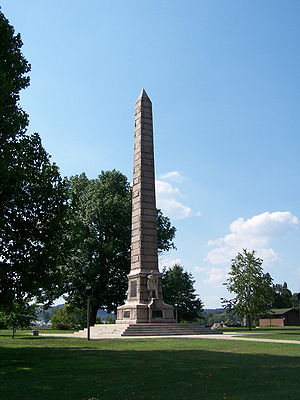Four workers were injured after a freight train derailed at a Wharncliffe, West Virginia coal plant and caused a nearby building to collapse, on Tuesday, July 21, 2009, around 7:30 a.m.

What could this obelisk dedicated to the Battle of Point Pleasant have to do with today's derailment? Take a short synchromystic journey to discover the answer.
Authorities told the Associated Press that the train's conductor and two coal plant workers pulled from the wrecked building suffered minor injuries. A fourth worker had to be airlifted to a hospital with serious injuries.
The Norfolk Southern Corporation train was pulling up under loading equipment when it derailed and hit a support. The loading equipment collapsed and knocked down a building. More details about the building were not available.
The Black Bear Preparation Plant in southern West Virginia employs about 30 people. The facility is operated by Cobra Natural Resources, which belongs to a subsidiary of Abingdon, Virginia-based coal producer Alpha Natural Resources.
The mine is located in Mingo County, West Virginia, and is surrounded by intriguingly named counties: to the north, Lincoln County, WV; to the northeast, Logan County, WV; and to the west, Pike County, Kentucky. Mingo, named after a Native American tribe, was created from an oversized Logan County, after a moonshiner was wrongly accused of having a still in Logan County, when, in fact, it was in Lincoln County.
The attempt to unionize coal miners in Mingo County in the 1920s led to the Battle of Blair Mountain in neighboring Logan County.
The Mingo are an Iroquoian group of Native Americans that migrated west to the Ohio Country in the mid-eighteenth century. One of their most famous leaders was Chief Logan.
The Battle of Point Pleasant, known as the Battle of Kanawha in some older accounts, was fought on October 10, 1774, primarily between Virginia militia and American Indians from the Shawnee and Mingo tribes (but probably not Chief Logan).
Along the Ohio River near modern Point Pleasant, West Virginia, American Indians under the Shawnee Chief Cornstalk attacked Virginia militia under Andrew Lewis, hoping to halt Lewis's advance into the Ohio Country. After a long and furious battle, Cornstalk retreated. After the battle, the Virginians, along with a second force led by Lord Dunmore, the Royal Governor of Virginia, marched into the Ohio Country and compelled Cornstalk to agree to a treaty, ending the war.
The battle is honored as the first battle of the American Revolution during "Battle Days," an annual festival celebrated in modern Point Pleasant. To memorialize the event, you will find the obelisk pictured above right there, near the river, in Point Pleasant, not too far from where the Silver Bridge use to stand.
The "Curse of Chief Cornstalk" is often mentioned in conjunction with Mothman and the collapse of the Silver Bridge, at Point Pleasant, West Virginia, on December 15, 1966.
1 comment:
I've been by Andrew Lewis' grave in Salem VA many times, it is also an impressive obelisk.
http://www.findagrave.com/cgi-bin/fg.cgi?page=gr&GRid=8862931
Post a Comment